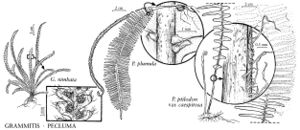Pecluma
Amer. Fern J. 73: 109. 1983.
| Taxon | Illustrator ⠉ | |
|---|---|---|
 | Pecluma plumula Pecluma ptilodon var. caespitosa Grammitis nimbata | John Myers John Myers John Myers |
Plants terrestrial, on rock, or epiphytic. Stems short-creeping, unbranched, 4–8 mm diam., not whitish pruinose; scales concolored, ovate to linear-lanceolate, not clathrate, glabrous or pubescent, margins entire. Leaves monomorphic, crowded, narrowed toward tip, to 90 cm. Petiole dark-brown to black, round in cross-section except for narrow lateral ridge decurrent from base of blade. Blade narrowly oblong to linear, usually pectinate, with more than (20–) 25 pairs of segments, not glaucous, pubescent, scales absent or on midrib only; rachis scaly and/or pubescent or glabrous abaxially, pubescent adaxially, scales basally attached and linear to cordate. Segments usually linear, 1.5–5 (–8) mm wide, adnate to costa, closely spaced, margins entire, apex acute. Veins 1–2-forked [simple], occasionally anastomosing. Sori terminal on veins, round; indument of branched glandular-hairs. Spores tuberculate. x = 37.
Distribution
North America, Mexico, West Indies, Central America, South America
Discussion
Within Polypodiaceae, Pecluma is distinctive in its short-creeping stems, pectinate blades (usually with more than 30 pairs of segments), and ungrooved, adaxially pubescent rachises.
Many species of Pecluma are well adapted to dry seasons. As the leaves dry out, the segments curl inwardly, presumably retarding moisture loss. After rains, the segments uncurl, apparently undamaged by the period of dryness.
Species ca. 30 (3 in the flora).
Selected References
Lower Taxa
Key
| 1 | Plants terrestrial or on logs or tree bases; segments at base of blade gradually reduced to auricles; petiole scales threadlike and inconspicuous or absent; veins 2–3-forked. | Pecluma ptilodon var. caespitosa |
| 1 | Plants epiphytic or on rock; segments at base of blade abruptly reduced, or base narrowed to truncate; petiole scales cordate and appearing inflated or hastate and flat; veins 1–2-forked. | > 2 |
| 2 | Leaves linear-elliptic; segments linear, proximal segments not deflexed, reduced abruptly to mere lobes; petiole scales cordate and appearing inflated; veins 1-forked; spores 64 per sporangium. | Pecluma plumula |
| 2 | Leaves narrowly ovate; segments narrowly ovate to linear, proximal segments deflexed, occasionally reduced to auricles; petiole scales hastate, flat; veins 2-forked; spores 32 per sporangium. | Pecluma dispersa |